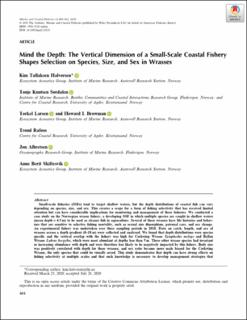| dc.description.abstract | Small‐scale fisheries (SSFs) tend to target shallow waters, but the depth distributions of coastal fish can vary depending on species, size, and sex. This creates a scope for a form of fishing selectivity that has received limited attention but can have considerable implications for monitoring and management of these fisheries. We conducted a case study on the Norwegian wrasse fishery, a developing SSF in which multiple species are caught in shallow waters (mean depth = 4.5 m) to be used as cleaner fish in aquaculture. Several of these wrasses have life histories and behaviors that are sensitive to selective fishing mortality, such as sexual size dimorphism, paternal care, and sex change. An experimental fishery was undertaken over three sampling periods in 2018. Data on catch, length, and sex of wrasses across a depth gradient (0–18 m) were collected and analyzed. We found that depth distributions were species specific and the vertical overlap with the fishery was high for Corkwing Wrasse Symphodus melops and Ballan Wrasse Labrus bergylta, which were most abundant at depths less than 5 m. Three other wrasse species had invariant or increasing abundance with depth and were therefore less likely to be negatively impacted by this fishery. Body size was positively correlated with depth for these wrasses, and sex ratio became more male biased for the Corkwing Wrasse, the only species that could be visually sexed. This study demonstrates that depth can have strong effects on fishing selectivity at multiple scales and that such knowledge is necessary to develop management strategies that balance fishing mortality sustainably across species, sizes, and sexes. We recommend that management priorities be directed toward the Ballan and Corkwing wrasses—the species having the highest vertical overlap with the fishery. Furthermore, CPUE was strongly affected by seasonality and positively correlated with increasing wave exposure for one of the species. This underscores the general importance of standardizing catch data for several environmental covariates when monitoring species that are affected by SSFs. | en_US |
